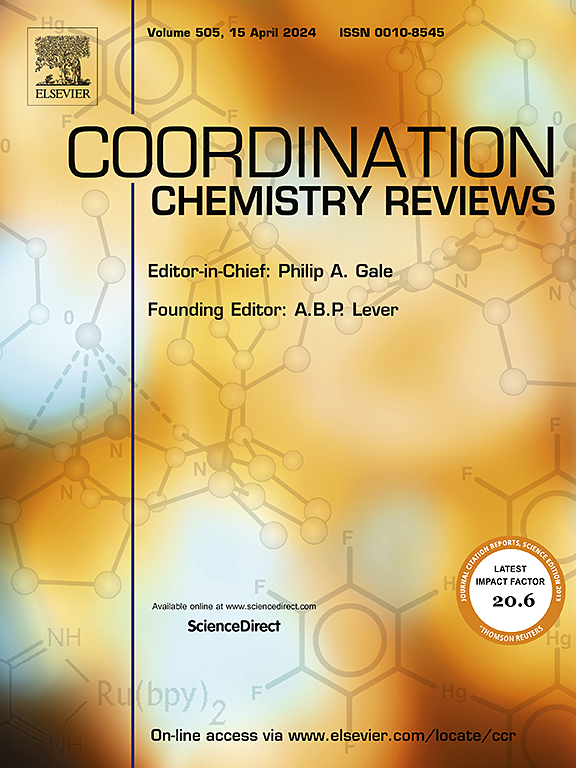增强纳米mof的细胞摄取和胞质递送:克服清除的合成方法和策略
IF 23.5
1区 化学
Q1 CHEMISTRY, INORGANIC & NUCLEAR
引用次数: 0
摘要
金属-有机框架(mof)由于其独特和有利的性能,已成为一个非常有前途的药物输送系统平台。这包括卓越的热、化学和水稳定性,生物相容性(当选择特定的金属和配体时),由于其簇和配体结构而具有高孔隙率,以及极大的表面积。正如这项广泛的研究所证明的那样,这些特征使mof非常适合吸附和输送各种药物。通过精心选择金属和配体,以及控制反应条件,如反应时间、温度、溶剂类型、pH介质、反应物摩尔比和调节剂的使用,研究人员可以精确地设计出MOF颗粒的形状、大小和整体结构。这篇综述彻底检查了在这些过程中使用的具体方法。它涵盖了各种合成技术,包括水热、溶剂热、回流、声化学、微波、电化学和机械化学方法。此外,本文还探讨了确保nMOFs生物相容性和有效生物医学用途所必需的材料和策略。特别关注的是MOF颗粒的大小、形状和最终形态,包括表面特征,因为这些参数对它们的细胞相互作用和吸收效率有重要影响。这些物理化学性质是至关重要的,因为它们直接影响了纳米颗粒在不破坏或失去结构完整性的情况下如何有效地穿过生物屏障并到达细胞内目标。本文章由计算机程序翻译,如有差异,请以英文原文为准。

Enhancing cellular uptake and cytosolic delivery of Nano MOFs: Synthesis approaches and strategies to overcome clearance
Metal-organic frameworks (MOFs) have become a highly promising platform for drug delivery systems, thanks to their unique and advantageous properties. These include exceptional thermal, chemical, and water stability, biocompatibility (when specific metals and ligands are selected), high porosity due to their cluster and ligand structure, and extremely large surface areas. Together, these features make MOFs exceptionally well-suited for adsorbing and delivering a wide range of drugs, as evidenced by this extensive research. By carefully choosing metals and ligands, along with controlling reaction conditions such as reaction time, temperature, solvent type, pH media, reactant molar ratios and the use of modulators, researchers can precisely design the shape, size, and overall structure of MOF particles. This review thoroughly examines the specific methods used in these processes. It covers various synthesis techniques, including hydrothermal, solvothermal, reflux, sonochemistry, microwave, electrochemical, and mechanochemical approaches. Additionally, the review explores the materials and strategies essential for ensuring the biocompatibility and effective biomedical use of nMOFs. Special attention is placed on the size, shape, and final morphology, including surface characteristics of MOF particles, as these parameters critically influence their cellular interactions and uptake efficiency. These physicochemical properties are crucial because they directly influence how effectively the nanoparticles can move through biological barriers and reach their intended intracellular targets without breaking down or losing their structural integrity.
求助全文
通过发布文献求助,成功后即可免费获取论文全文。
去求助
来源期刊

Coordination Chemistry Reviews
化学-无机化学与核化学
CiteScore
34.30
自引率
5.30%
发文量
457
审稿时长
54 days
期刊介绍:
Coordination Chemistry Reviews offers rapid publication of review articles on current and significant topics in coordination chemistry, encompassing organometallic, supramolecular, theoretical, and bioinorganic chemistry. It also covers catalysis, materials chemistry, and metal-organic frameworks from a coordination chemistry perspective. Reviews summarize recent developments or discuss specific techniques, welcoming contributions from both established and emerging researchers.
The journal releases special issues on timely subjects, including those featuring contributions from specific regions or conferences. Occasional full-length book articles are also featured. Additionally, special volumes cover annual reviews of main group chemistry, transition metal group chemistry, and organometallic chemistry. These comprehensive reviews are vital resources for those engaged in coordination chemistry, further establishing Coordination Chemistry Reviews as a hub for insightful surveys in inorganic and physical inorganic chemistry.
 求助内容:
求助内容: 应助结果提醒方式:
应助结果提醒方式:


